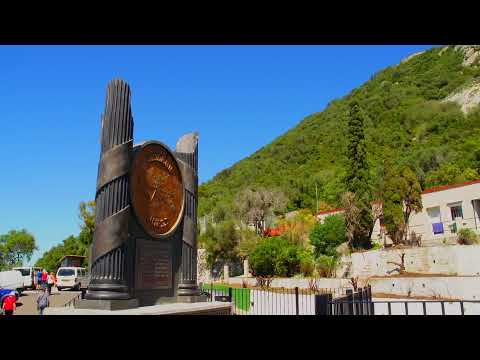
Nestled at the southern tip of the Iberian Peninsula, the Rock of Gibraltar stands not only as a striking natural fortress but also as one of the historical and mythical Pillars of Hercules. This monumental pair, consisting of Gibraltar in Europe and Mount Abila or Jebel Musa in Africa, frames the narrow strait that links the Atlantic Ocean to the Mediterranean Sea. The Pillars have long been steeped in legends and have played a pivotal role in navigational histories since ancient times.
#### Historical and Mythological Significance
The story of the Pillars begins with their name, derived from one of the most famous figures in Greek mythology—Hercules. According to legend, it was Hercules who created both the Rock of Gibraltar and its African counterpart by splitting a mountain in two. This act formed what is known today as the Strait of Gibraltar, marking not only a physical divide between Europe and Africa but also symbolizing the edge of the known world. Ancient mariners considered passing through these pillars a formidable task, one that ventured into realms unknown.
The Greeks associated this site with their mythological limit marked by a warning: “Nec plus ultra,” meaning “nothing further beyond.” However, this notion was radically challenged during the Age of Discovery when explorers like Christopher Columbus surpassed these geographical boundaries to discover new worlds across the Atlantic.
#### Geographical Overview
Gibraltar itself is an imposing monolithic limestone promontory that rises majestically from sea level to a height of over 400 meters (1,312 feet). It covers an area slightly less than six square kilometers (2.3 square miles) yet has been strategically significant throughout history due to its commanding position at one end of the strait bearing its name—the Strait of Gibraltar. Only 14 kilometers (about 9 miles) wide at its narrowest point, this navigational chokepoint connects and separates two continents and two major bodies of water.
#### Modern Day Gibraltar
In modern times, Gibraltar is an overseas territory under British sovereignty since it was ceded from Spain in 1713 under the Treaty of Utrecht. Its fascinating mix involves both colonial British influences and traditional Andalusian Spanish culture which coexist in this unique melting pot. The Rock is famously known for its wildlife sanctuary on its upper area where Barbary macaques—the only wild monkey population on the European continent—roam freely.
Touristically, Gibraltar offers more than just panoramic views from its famed Upper Rock. Inside “the Rock” itself are networks of tunnels that were expanded during World War II which serve as museums today and recounting military history that spans many centuries. Additionally, Moorish Castle and St Michael’s Cave attract thousands each year with their historic allure and natural beauty.
#### Ecological Importance
As a Mediterranean ecosystem clinging onto a singular geological feature, Gibraltar’s flora and fauna are quite distinctive. Conservation efforts are ongoing to preserve these unique ecological zones alongside maintaining biodiversity which includes migratory birds using this route to cross between continents twice annually.
#### Conclusion
The Pillars of Hercules continue to be emblematic not merely as geographical markers but also as symbols bridging myth with reality—a testament to human curiosity pushing beyond familiar horizons into uncharted territories. From ancient mythology that frightened sailors away from purported edges of flat earths to becoming central points on globe-spanning routes: The Pillars stand resiliently watching over changes wrought by time yet remain gatekeepers guarding timeless tales at where worlds meet.
